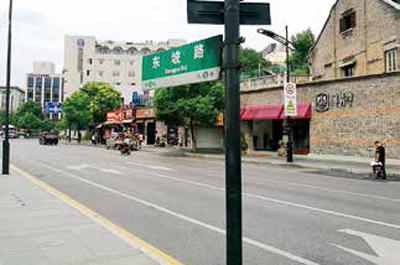A Random Look at Old Street Names in Hangzhou
2019-02-25CaoXiaobo
Cao Xiaobo



About 100 years ago, Hangzhou hardly had any modern structures called roads and streets as they are known now. The walled city had ten gates, connected to downtown through some short straight lanes. A book published toward the last years of the Qing Dynasty (1644-1911) records a great variety of lanes, proving the fact that there were hardly any streets in the city. If some were called streets, they were misnomers. They were nothing but lanes, in retrospect.
The lakeside Hubin Road on the eastern shore of the West Lake and neighboring areas used to be a large military base. Old-time records say that the base was home to over 130 military offices and barracks including the office where the military governor of the province worked. The offices and barracks were torched in 1861 when the army of the Taiping Rebellion ransacked the city. The barracks were restored to some extent after the Taiping rebels were annihilated. In 1912, the year when the royal court ceased to rule the country, the barracks were dismantled due to a decision by the military government of the province. The 670,000-square-meter plot later became a key part of downtown Hangzhou, ushering in roads and streets in the modern sense.
After the base was dismantled, the city government wanted to raise funds for urban development by selling the plot. But there were few buyers. In 1914, YMCA bought a part of the plot. Then the name Youth Lane appeared. The YMCA compound is still there.
The modern Hangzhou originally had four main streets which formed a structure like the Chinese word 井. Three were named in an infamously controversial way. After that, some new streets and roads were named after ancient celebrities such as Su Dongpo, Bai Juyi, Yue Fei, etc. The poet Bai Juyi of the Tang Dynasty (618-907) served as Hangzhou governor and had a long causeway built in the West Lake. The causeway is now Bai Causeway and the road in lakeside Hubin area is Baifu Road. Fu in the name refers to the reverent position Bai once held: he served as a private tutor to the crown prince. Qiwang Road was named after Han Shizhong, a general who fought the invading nomad from the north. Qiwang means Duke Qi. Xueshi Road (Scholars Road) was named in honor of a Jiang family in the Ming Dynasty (1368-1644). The family produced six scholars in four generations who came out first in the top-level imperial examination. Huixing Road was named after a Manchu woman who dedicated herself to the education of women.
, a book authored by Shi Keshi and published in 1934, says there were 20 plus asphalt streets and 30-some macadam roads in the city, but it does not list the names of these roads and streets. Back then, the city had streets and roads named after some modern celebrities including Dr. Sun Yat-sen, Zhang Jingjiang, Song Jiaoren, Huang Fu, Chen Qimei, Ruan Xingcun and many others.
Zhongshan Road was named in honor of Dr. Sun Yat-sen. Many cities in China have a road named after the founding father of the Republic of China.
Chuanfang Road was named after warlord Sun Chuanfang who led his army to Hangzhou in 1924. The name was scrapped after the warlords troops were annihilated. Situ Road was named after John Leighton Stuart, son of an American missionary born and brought up in Hangzhou. It was not until November 1946 that it changed to its present name Yesutang Lane (Christian Church Lane). Zhongzheng Road was named after Chiang Kai-shek who ruled China for about 20 years before he was defeated in the civil war and fled to Taiwan Island in 1949.

A view of Dongpo Road, in honor of Su Dongpo, a poet of the Song Dynasty

A view of Zhongshan Road

A view of Hefang Street West
Xingcun Road named after Ruan Xingcun. The road was previously known as Court Road, where Zhejiang Supreme Court was housed in a magnificent building painted in red. Nowadays only half of the court house remains as a historical site. Ruan Xingcun, a young lawyer, studied law in Japan and started his private law firm after he came back from overseas. He was one of the first who bravely promoted the modern legal system in the province. In 1927, he was appointed to head the provincial law department. On January 28, 1928, he dropped dead in his office at the court house. In February, the road that ran in front of the court house was renamed Xingcun Road.
All these names, if related appropriately, would add up to a history of the Republic of China (1911-1949).
On December 14, 1946, the city government renamed quite a few streets and roads. Jianguo Road (Building the Nation Road) and Fuxing Road (Reconstruction Road) reflected both the ecstasy of the 1945 victory of Chinas war of resistance against Japanese aggression and the hope of national rebuilding and prosperity.
In August 1949, most names of the celebrities of the republican years were removed from the streets of Hangzhou. Zhongshan Road remains unchanged; Zhongzheng Road became Jiefang Road (Liberation Road).
